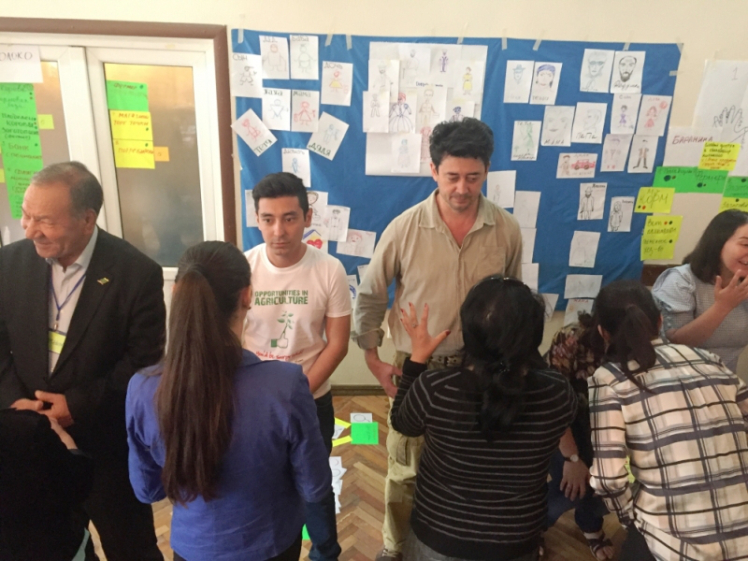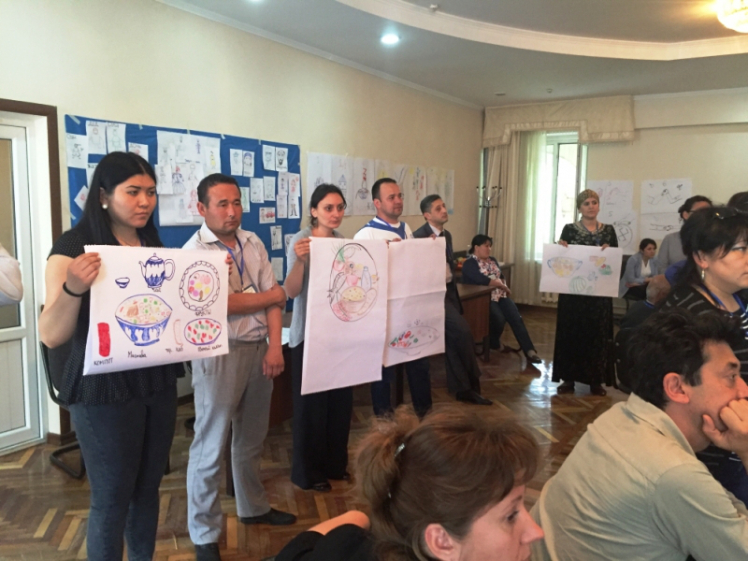-
About
- Our Work
- Get Involved
- Stay Updated
Why do we need trainings?

This blogpost by Rustam Ibragimov originally appeared on the GFAR blog.
Dear Sir/Madam,
We are pleased to invite you to participate in the training Integrating gender and nutrition issues in agricultural extension systems…
With this letter of invitation, I got an opportunity to participate in the practical training-workshop organized by INGENAES and CAC-FRAS where different stakeholders were involved.
After completing it, I had the usual feeling of satisfaction that I had acquired new skills and knowledge in the issues of gender and nutrition. However, sometime later, I realized that there is something more than just being trained. It is about imperceptible advantages that are hard to notice at first sight.
In this regard, it is reasonable to ask – Why do we need trainings?
In order to convey what these benefits were personally for me, I am going to mention some of the practical exercises within the framework of the training. Some had an ‘obvious benefit’ and others an ‘unseen asset’.
Breaking the ice
The introductory exercise, ‘juggling’, had participants gather in a circle and in turn throw an item while saying each other’s names. Here, most would say that it is a good exercise for remembering the names of people.
However, it turns out that by doing this simple activity, people were able to steadily establish a connection, an unseen thread between each other so that they could work in the coming days much more easily. Highly effective technique, I must say.
Learning the specifics of different cultures and traditions
‘Men and Women: Power over (the domination of one sex over another) vs. Power with (both genders work together)’ was actually an illustrative exercise where we needed to come up with a symbol for our conceptions of ‘power over’ and ‘power with’. The organizers wanted the participants to show how men and women can act in conjunction against a dynamic of domination (most frequently the power of men over women).
The outcome of this drawing session was the obvious advantage of seeing how people understand these two kinds of power. Nevertheless, I perceived an unseen benefit for the participants in the opportunity to learn about the cultures of other countries and their social constructs. It was an opportunity for us to exchange our knowledge and understanding from our own cultural standpoint.
During the group work, it was curious to observe how people from various countries of Central Asia and the Caucasus described the mentioned concepts on their country level by emphasizing the aspect of traditions and culture as the main triggers.
A nutritionally balanced diet – spreading the word

Considering the issue of nutrition, the organizers asked us to draw a picture of the nutritionally balanced meals for one typical day in a rural area. Obviously, the aim of the exercise was to identify whether the participants know how to “eat right” and in case they do not, explain it to them. Nevertheless, there is more to it than just identifying and explaining what others in remote areas should eat. In my opinion, the true mission of this exercise was to advocate and disseminate the information on healthy eating habits to bring participants to realize what is needed to make our generation healthy. The more people know and put it into practice – the healthier the lifestyle.
Here in my shoes just to see,
What it is like to be me…
The exercise called ‘Gender myths’ was my favorite. It was based on a role-play, which intended to show a typical rural family and the interaction between each member on at household level. I have to say that this exercise would not be so special without one distinctive feature: each group member was encouraged to change their roles: men played the role of women and vice versa.
Normally, a ‘typical advantage’ of conducting the role-play was mainly to experience ourselves what it is like to do the housework while acting as an opposite gender. In other words, all of us felt the burden carried by a rural man and a rural woman.
Nonetheless, I believe that an ‘unseen asset’ from this exercise was recognition of the burning issue of gender inequity existing in rural areas. The colossal work of women is underestimated and their rights are infringed. Women farmers control less land than men, have less opportunities for education and access to innovations, information and various services (e.g. extension), etc. Moreover, in cases when they are employed, women receive lower salaries compared to men where both gender representatives do the same work and have equal qualifications and expertise (FAO’s Gender and Land Rights Database, 2015). These facts are just the tip of the iceberg; if we look deeper, we can reveal more. In this concern, the organizers intended to highlight that we have to act accordingly and make a significant impact on a local level to change these trends.
Having had this experience, I am now confident to state that trainings serve not only as ways of learning new skills and knowledge, but as food for thought, ‘temples’ where trainees are inspired to action. Equipped with these ‘unseen assets’, trainees can even be compared to ambassadors who take their newly acquired knowledge and skills and spread the message on hot issues to those they encounter. When done right, a training can truly teach you what it’s like to be in another’s shoes..
Watch an interview with Jan Henderson, Senior Capacity Development Specialist, University of Illinois, who provided an overview of the training (objectives, expectations, outcomes) and shared the plans on the follow-up actions
Blogpost and video by Rustam Alimjanovich Ibragimov, #GCARD3 Social Reporter –r.a.ibrakhimov(at)gmail.com. This post represents the author’s views only.
Photo Credit: Rustam Ibragimov
Tags:About the author
Author's recent posts
More posts from authorRelated Posts
Comments
No comments made yet. Be the first to submit a commentBy accepting you will be accessing a service provided by a third-party external to https://archive.ypard.net/
Get in touch
Email: [email protected]
YPARD Global Coordination UnitHosted by AGRIDEA and the Czech University of Life Sciences Prague
Lausanne, Switzerland and Prague, Czech Republic - Our Work

